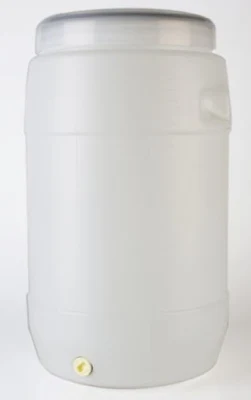I saw on the 'net there had been some debate on NOT using plastic fermenters because of the risk of beer infection.
I thought this was a subject worth investigating further.
All I ever use is plastic fermenters and having only ever had one incident of infection which occurred to two different fermenters used in the same batch, I could be confident that I've never had an infection caused by using a plastic fermenter (what would the odds have been?!)
So what's the argument from the naysayers?
The reasoning is that given plastic is more easily scratched than glass those scratches can harbor bacteria so, the risk of infection is greater.
This seems a reasonable argument right?
And the simple solution would be to not scratch the plastic as you are cleaning and sanitizing right?
Given my experience and the fact, there are millions of plastic fermenters safely and happily in use around all corners of the globe, then there is nothing much to worry about.
That's provided of course that you follow a proper cleaning process before you add your beer wort for primary fermentation.
Any decent beer brewer will tell you that the number one key to beer making success is by adopting methodical cleaning and sanitization practices every time you make beer.
We've covered this need before, but our favorite trick is to use sodium percarbonate and not being shy about using boiling water to kill bugs.
Home brewers around the world often swear by the ability of PBW to get their brewing gear brew ready.
So, to be clear I don't see the threat of infection as a reason to not use a plastic fermenter.
Sure, if they get too old or scratched you might totally want to replace one but on a cost basis when compared to glass carboys, they are a lot cheaper, indeed a check on Amazon shows that a carboy is generally roughly twice the price.
Indeed, if you are new to home brewing, the use of a plastic drum is a great way to start where you don't have to worry about damaging the glass!
Oxygen and beer aging
Aging beer is perhaps a reason that you may wish to use something other than a plastic fermenter. The reasoning here is that it's a bit easier for oxygen to enter the beer via plastic than it is beer.
If you weren't aware, other then when first mixing the wort, beer is best brewed with minimal exposure to O2 - and it's the same when bottling your beer as well.
That said the difference in permeability between glass and plastic arguably negligible when you consider most oxygen exchange is occurring through the bung and airlock.
ALSO, if you are trying to mimic the effect of a barrel-aged beer using oak, then some brewers do consider that some oxygen will help!
What you could do is do your primary fermentation in plastic and then if you intend to age a stout or whatever for a long time, you can transfer it to a secondary glass carboy.
Also (2!) bare in mind that by making such a transfer you create an opportunity for oxygen to enter the beer.
Whatever way you go, you totally need to keep your vessel free from a large amount of oxygen entering as it can assist with the growth of mould or other nasties and we really don't want that do we?
As you can see, it's a vicious cycle of contradictory information!

0 comments:
Post a Comment